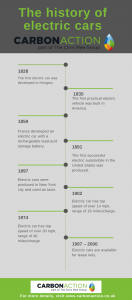Lithium Electric Vehicle Car Vehicles – “What you need to know.”
Over the next three weeks Fergal Mee (Director of GHG Service with Carbon Action) and his team will be sharing with you a series of articles based around Electric Vehicles. Weekly topics will include;
1. The history of electric cars
2. Performance comparisons between hybrids/combustion engine
3. The importance of measuring the life cycle emissions
4. Conclusion and Supplementary information
When an electric vehicle (EV) is running on electricity, it emits no tailpipe (also known as direct) emissions. When evaluated on that factor alone, EVs are more eco-friendly than conventional gasoline-or diesel-powered vehicles on the market today. However, when evaluating the eco-friendliness of an electric vehicle, we also need to take the well to wheel emissions into account. This is an overarching term that includes greenhouse gas and air pollutants that are emitted to produce and distribute the energy being used to power the car. Electricity production results in a varying amount of emissions depending on the resource. While “being green” in the act of driving your electric vehicle is a start, if your primary goal in purchasing an electric vehicle is to reduce your greenhouse gas and pollutants emissions, you should also prioritize using zero-emissions electricity wherever possible.

The history of electric cars
1828 The first electric car was developed in Hungary
1835 The first practical electric vehicle was built in America.
1859 France developed an electric car with a rechargeable lead-acid storage battery.
1891 The first successful electric automobile in the United States was produced.
1897 Electric cars were produced in New York city and used as taxis.
1902 Electric car has top speed of over 14 mph, range of 18 miles/charge.
1974 Electric car has top speed of over 30 mph, range of 40 miles/charge
1997 – 2000 Electric cars are available for lease only.
Production of electric vehicles by the beginning of the 20th century had reached 10 thousand units in the United States, and their number was several times higher than the number of gasoline vehicles.
In 1899, an electric car was able to overcome the barrier of 100 km/h. This momentous event happened in the French town Asher, near Paris. Electric vehicle record was created by the Belgian Camille Jenatzy. The car had a streamlined body of aluminium alloy and tungsten. Its appearance resembled a torpedo, installed in the chassis. The body of the electric vehicle was open. It was equipped with two motors and had a mass of about 1 ton. This electric car reached a speed of 105,88 km/h. This innovation of the late nineteenth century is shown in figure 1 below:-
E Car Research
There are today over 100 research articles that cover the environmental impacts from lithium-ion batteries dating back to as early as 1999. The focus in the research varies, as do the methods. For this reason the results are also widely different with a climate impact ranging from 39 kg CO2e/kWh to 196 kg CO2e/kWh .
Sign up here to receive the next article in this series directly to your inbox
If you require further information or assistance please contact us via email at info@carbonaction.co.uk or by phone at +44 (0)20 3869 1869.





